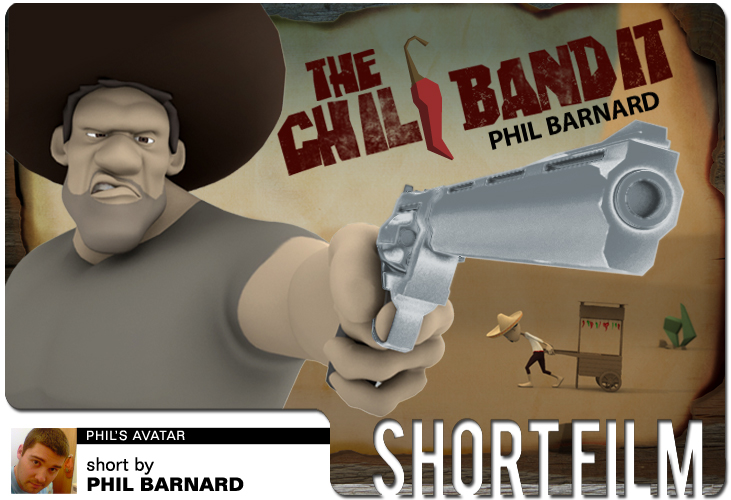Chili Bandit: A Short Film by Animation Mentor Alumnus Phil Barnard
Please download Flash Player 10 to view video.
Download at http://get.adobe.com/flashplayer/
Animation Mentor:
How did you come up with the concept for your short film?
Phil Barnard:
I had a chili plant that produced really hot chilies. I always thought it would be cool to animate somebody trying to eat one and the devastating effects it would have on them. Every time I thought about using the chili idea I kept imagining a little Mexican guy pulling his cart along the desert. I guess it was just a case of bringing those ideas together as a starting point and building a story around them.
Animation Mentor:
What important lessons did you learn from making your short film?
Phil Barnard:
The most important lesson I learned was to plan. I'm so glad I spent a good amount of time working out as much as I could before I started any animation. I guess it's normal for things to change throughout the animation process. My final animation is very different from my animatic, but it was great to have some solid planning to look back at when I was unsure about things or needed to remember what I originally wanted to achieve.
Animation Mentor:
What was the best piece of advice you received from your mentor or your peers?
Phil Barnard:
Keep it simple! I heard this a lot from many different people, and it's so true. When I got to the short film class we had to keep the film under 30 seconds. This was great because it forced us to really think about the story and what we really needed in order to tell it. Keeping it short and simple really allowed me to polish each shot before finishing the course and I feel I got the most out of my mentor's critiques.
Animation Mentor:
What were the steps in your planning process?
Phil Barnard:
I worked with my mentor, Dana Boadway, to get the story correct. I knew the story would take place in a desert, so I created a simple set. I spent a lot of time watching movies. I do that anyway, but I kept post-it notes next to me, and every time I saw a cool shot I quickly sketched it out. This became really great reference when I got into my animatic. Once I had my shots set up, I did some thumbnails and shot video reference to work out exactly what the characters' actions would be.
Animation Mentor:
Do you mind sharing some of the pre-production work with us with a little explanation of what we're looking at?
Phil Barnard:
As you can see, the final version is very different from the animatic. I got some great suggestions throughout the making of my short film. Jason Taylor's critiques were amazing and some of his suggestions were just too good not to try.
Please download Flash Player 10 to view video.
Download at http://get.adobe.com/flashplayer/
Please download Flash Player 10 to view video.
Download at http://get.adobe.com/flashplayer/
Please download Flash Player 10 to view video.
Download at http://get.adobe.com/flashplayer/
Please download Flash Player 10 to view video.
Download at http://get.adobe.com/flashplayer/
Please download Flash Player 10 to view video.
Download at http://get.adobe.com/flashplayer/
Please download Flash Player 10 to view video.
Download at http://get.adobe.com/flashplayer/
These are a few of the many thumbnails I did. I created these in flipbook so that I could easily create quick pencil tests to see how my poses worked together.

Animation Mentor:
What obstacles, if any, did you experience during the creation of your short film? How did you work your way around them?
Phil Barnard:
My biggest obstacle was time. I was working full time and only had nights and weekends to work on my animation, so creating a short film really proved to be a difficult task. My original idea would have been impossible to complete, but working with my mentor, I was able to cut it down to a manageable length while still keeping the story I wanted to tell.
Animation Mentor:
How did Animation Mentor help you create your short film?
Phil Barnard:
When I started the course, I was unsure whether I would have the ability to finish a short film, but Animation Mentor helped me every step of the way. They provided me with some of the most amazing mentors right from the start (Raquel Rabbit, Keith Sintay, T.Dan Hofstedt, Bret Parker, Dana Boadway and Jason Taylor). Their great critiques really helped me develop as an animator and gave me the skills I needed to finish the short film within the time frame.
Animation Mentor:
What advice do you have for other students who haven't started their short film yet?
Phil Barnard:
Keep it simple and try to have a clear goal of what you can achieve in the time you have. Do lots of planning so that you have most of your questions answered before jumping into Maya.
Show your work as often as possible. Some of the major changes to my short happened because of to the amazing feedback I received from my classmates.

